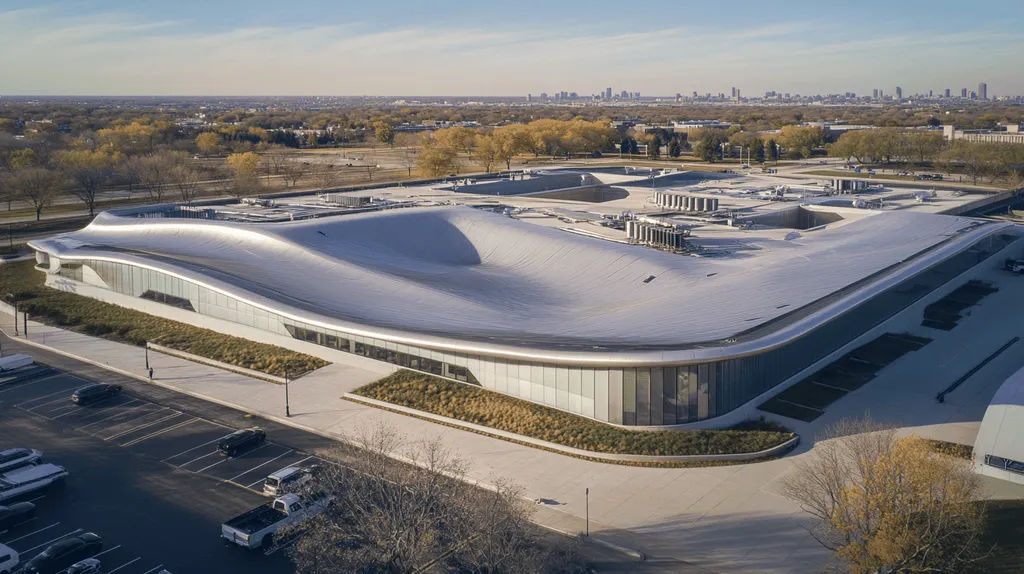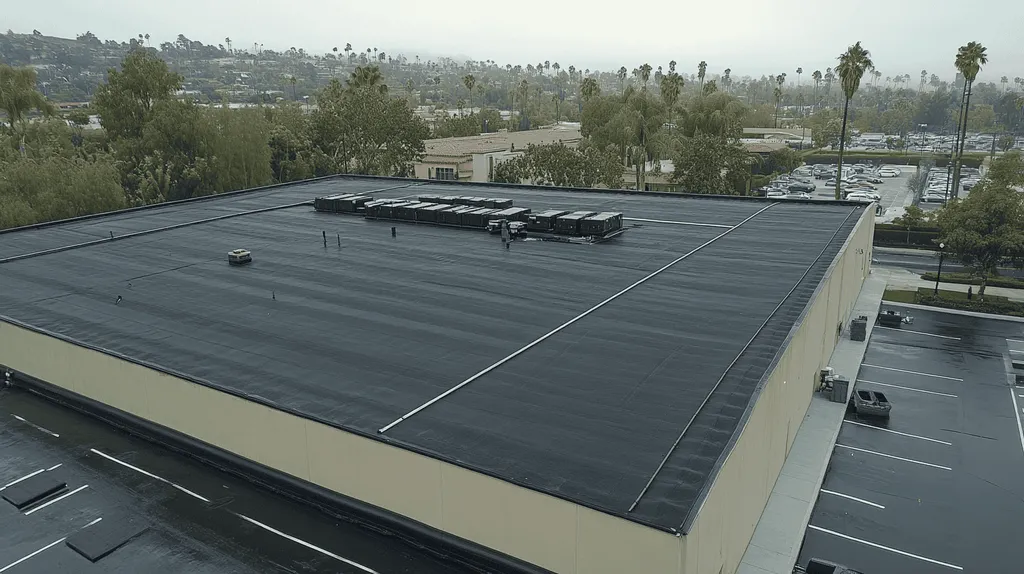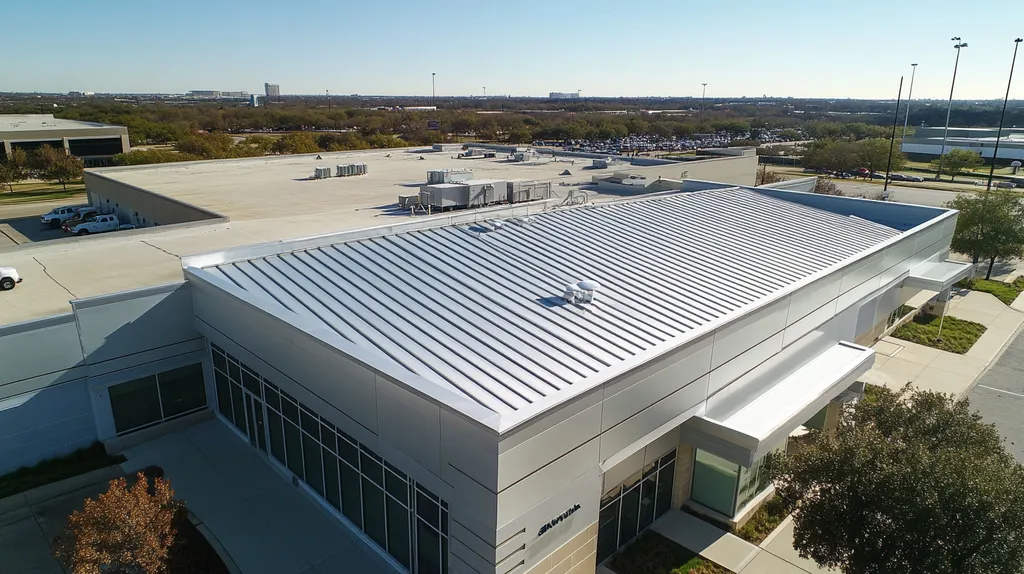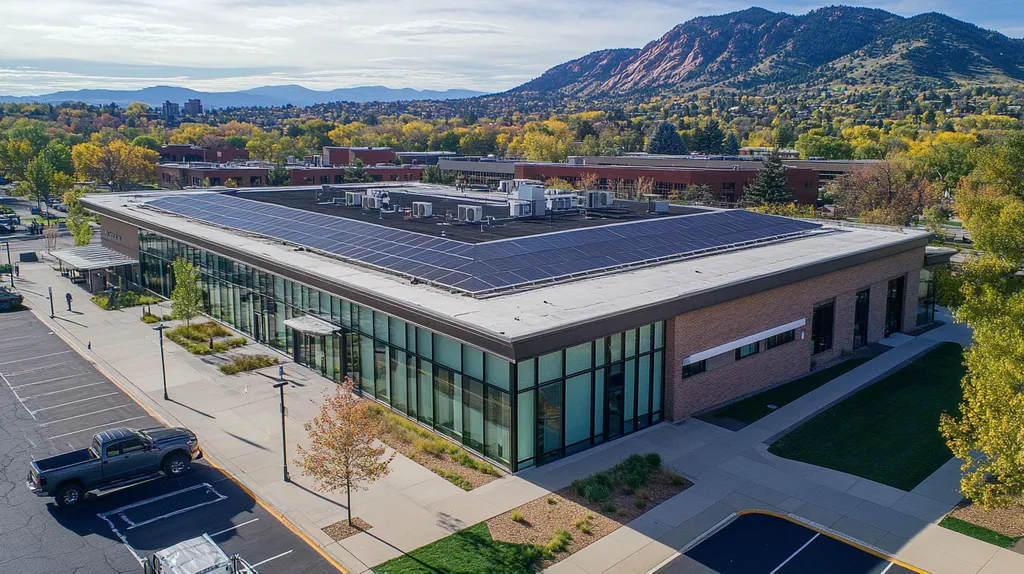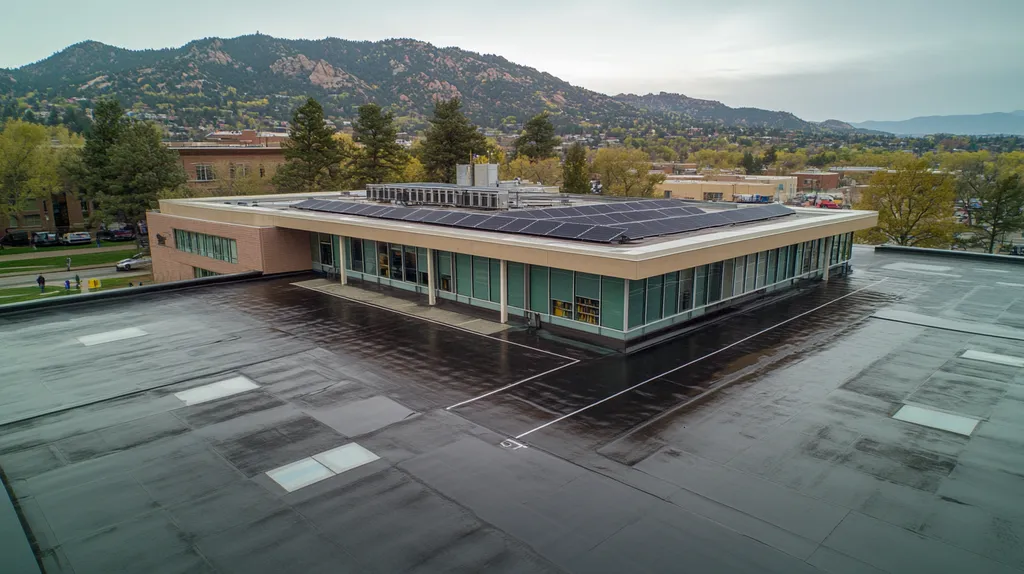Every year, commercial building owners lose millions in energy costs and repair expenses due to poorly timed roof coating projects. Industry studies show that implementing coating applications at the wrong time can reduce effectiveness by up to 40% while doubling installation costs.
Understanding the precise timeline for coating applications – from initial assessment through final curing – has become critical for protecting commercial roofing investments. Modern coating systems require specific temperature ranges, humidity levels, and surface conditions to achieve optimal performance.
This comprehensive guide breaks down the essential phases, timing considerations, and environmental factors that determine coating project success.
SECTION 1: THE BASICS EXPLAINED
Commercial roof coating represents a critical investment in building infrastructure, directly impacting operational costs and facility longevity. Studies show that properly timed roof coatings can extend a roof’s lifespan by 10-15 years while reducing cooling costs by up to 30%. For facility managers, understanding the coating timeline isn’t just about maintenance—it’s about protecting assets and optimizing building performance through strategic planning.
What It Is (In Plain Language)
A roof coating system consists of specialized liquid materials that create a seamless, waterproof membrane over existing commercial roofing. These coatings form a protective barrier that shields the underlying structure from UV radiation, water infiltration, and thermal stress.
Modern coating systems come in several formulations, including acrylic, silicone, and polyurethane. Each type offers specific advantages for different roofing materials and environmental conditions.
The coating process transforms an aging roof surface into a renewed protective shield without the disruption and expense of complete replacement. This restoration approach preserves the existing roof while adding years of serviceable life.
Most importantly, these systems provide immediate protection while offering long-term performance benefits that compound over time.
Why It Matters (To Your Building)
Proper roof coating directly impacts a facility’s bottom line through reduced energy costs, extended roof longevity, and minimized repair expenses. An uncoated or improperly coated roof can lead to premature aging, increased maintenance costs, and potential structural damage.
Energy efficiency represents one of the most significant benefits. Reflective coatings can reduce roof surface temperatures by up to 100 degrees Fahrenheit during peak summer conditions.
Water infiltration prevention remains crucial for protecting building contents and maintaining structural integrity. Even minor leaks can escalate into major repair projects if left unaddressed.
The coating investment typically pays for itself through reduced cooling costs and avoided repairs within the first few years after application.
How It Works
The coating process requires careful attention to environmental conditions for optimal results. The ideal application environment demands temperatures above 50°F with humidity between 40-60% to ensure proper adhesion and curing. (source: SmartSeal)
Installation begins with thorough surface preparation, including cleaning, repairs, and primer application where needed. This preparatory phase proves essential for achieving maximum coating performance and longevity.
Application methods vary by coating type and roof configuration, utilizing spray equipment, rollers, or brushes to achieve uniform coverage. Multiple layers may be required to reach the specified thickness.
The curing process depends on environmental conditions, with most systems achieving initial set within 24 hours and full cure within several days. During this period, the coating develops its full protective properties.
Regular inspections and maintenance after installation help ensure the coating system delivers its expected performance throughout its service life.
SECTION 2: PRACTICAL APPLICATIONS
Commercial roof coating decisions directly impact facility operations, maintenance costs, and building longevity. Recent industry data shows that properly timed coating applications can reduce repair expenses by up to 70% compared to reactive maintenance. However, many facility managers struggle with identifying optimal application windows and understanding system interactions, leading to premature roof deterioration and increased operational costs.
Common Uses & Examples
Modern roof coatings serve multiple critical functions in commercial and industrial settings. Beyond basic waterproofing, these systems provide enhanced UV protection, temperature control, and surface durability for various roofing substrates.
Large retail facilities often utilize reflective coatings to dramatically reduce cooling costs during peak summer months. These applications can lower roof surface temperatures by up to 80 degrees Fahrenheit, providing immediate energy savings.
Manufacturing facilities frequently employ chemical-resistant coatings to protect against industrial emissions and atmospheric pollutants. This specialized protection prevents premature degradation of roofing materials in harsh industrial environments.
Distribution centers and warehouses benefit from reinforced coating systems that resist foot traffic and equipment impacts. These enhanced formulations maintain waterproof integrity despite increased rooftop activity.
When You Need It Most
Applying a roof coating requires careful timing based on environmental conditions and roof condition. Projects typically span 1-3 days depending on roof size and complexity, with surface preparation and multiple coating layers essential for optimal performance. (source: NBC SC)
Seasonal considerations play a crucial role in coating success. Spring and fall generally offer ideal application conditions with moderate temperatures and humidity levels that support proper curing.
Visible signs of wear, including surface oxidation, minor leaks, or decreased reflectivity, indicate immediate coating needs. Early intervention prevents more extensive damage and preserves underlying roofing materials.
Emergency situations such as storm damage or sudden leaks may require immediate coating attention. Quick response with appropriate coating solutions can prevent water infiltration and structural deterioration.
Interactions With Other Systems
Roof coatings significantly impact building envelope performance through their interaction with other facility systems. These relationships affect everything from energy efficiency to equipment longevity.
HVAC systems benefit directly from properly applied roof coatings. Reduced heat transfer through coated surfaces decreases cooling loads, extending equipment life and reducing operational costs.
Building automation systems can operate more efficiently when integrated with reflective roof coatings. Temperature sensors and climate controls respond more effectively to external conditions when working in conjunction with well-maintained coating systems.
Drainage systems require special consideration during coating applications. Proper coating thickness and application techniques ensure water flow patterns remain unobstructed while maintaining waterproof integrity.
Solar panel installations and other rooftop equipment perform better when surrounded by reflective coatings. The reduced ambient temperature helps maintain optimal operating conditions for sensitive electronic components.
SECTION 3: KEY TERMINOLOGY DECODED
Clear communication drives successful roof coating projects, yet industry terminology often creates costly confusion. Research shows that terminology misunderstandings contribute to 40% of project delays and budget overruns in commercial roofing. Understanding key terms isn’t just about speaking the language—it’s about protecting your investment and ensuring optimal project outcomes.
Essential Terms Explained
Coating systems represent the protective layer applied to existing roofs, combining multiple components to create a waterproof barrier. These systems include primers, base coats, and top coats, each serving specific protective functions.
Substrate refers to the existing roof surface receiving the coating. Different substrates—whether metal, modified bitumen, or single-ply membrane—require specific coating formulations for optimal adhesion and performance.
Adhesion measures how well the coating bonds to the substrate. Poor adhesion leads to coating separation, while proper adhesion ensures long-term protection and performance.
Surface tension and coating mil thickness directly impact material performance. These factors determine how evenly the coating flows and its final protective capabilities.
Industry Jargon Translated
Solar reflectance index (SRI) measures a coating’s ability to reject solar heat. Higher SRI values indicate better cooling performance and greater energy savings potential.
Vapor barriers control moisture movement through the roof assembly. Understanding vapor barrier requirements prevents condensation issues that can compromise coating performance.
Roof pitch describes the angle or slope of the roof surface. Proper pitch understanding ensures appropriate coating selection and application techniques for optimal drainage.
Temperature and humidity significantly impact coating success, with ideal conditions requiring temperatures above 50°F and humidity between 40-60% for proper curing and adhesion. (source: SmartSeal)
Measurement & Units Simplified
Coverage rates indicate how much area one gallon of coating will protect. Standard rates range from 80-100 square feet per gallon, varying by coating type and substrate condition.
Dry film thickness (DFT) measures the final coating thickness after curing. Proper DFT ensures adequate protection while preventing material waste through over-application.
Elongation percentage reveals how much a coating can stretch without breaking. Higher elongation values indicate better performance in buildings subject to thermal movement.
Wind uplift resistance ratings define how well coatings withstand wind forces. Understanding these ratings ensures appropriate system selection for specific building locations and heights.
SECTION 4: DECISION FACTORS
Making informed decisions about commercial roof coatings requires careful evaluation of multiple interrelated factors that impact both immediate and long-term facility performance. Research indicates that poorly planned coating projects can increase operational costs by up to 40% while reducing roof lifespan by half. Understanding the relationship between cost, performance, and durability helps facility managers avoid costly mistakes and maximize their roofing investment.
Cost Considerations
Initial coating costs typically range from $2-8 per square foot, but focusing solely on upfront expenses often leads to poor long-term outcomes. Material quality, application complexity, and roof condition all influence total project costs.
Labor represents 40-60% of coating project expenses. Professional application teams with proper training and equipment deliver superior results that reduce future maintenance needs.
Energy savings from reflective coatings can offset installation costs within 3-5 years through reduced cooling expenses. These savings compound over time, especially in warmer climates.
Warranty coverage varies significantly between coating systems. Premium materials often include longer coverage periods and more comprehensive protection against defects.
Performance Trade-offs
Different coating formulations offer distinct advantages and limitations that must align with facility requirements. Applying a fluid-applied roofing system demands careful attention to manufacturer specifications and proper surface preparation to achieve optimal results. (source: Roofing Magazine)
Silicone coatings excel at moisture resistance but may accumulate dirt more readily than other options. This trade-off affects both appearance and long-term reflectivity.
Acrylic systems provide excellent UV protection and color stability but may not perform well in ponding water conditions. Climate and drainage patterns should guide coating selection.
Application temperature requirements vary between coating types. Some systems require specific environmental conditions for proper curing, potentially impacting project scheduling.
Lifespan & Durability Factors
Expected coating lifespans range from 10-20 years depending on environmental conditions and maintenance practices. Regular inspections and prompt repairs significantly extend service life.
UV exposure represents the primary aging factor for most coating systems. Geographic location and roof slope influence degradation rates and recoating intervals.
Physical damage from foot traffic, equipment maintenance, and debris impact requires consideration when selecting coating durability levels. High-traffic areas may need reinforced systems.
Chemical resistance becomes crucial near HVAC equipment or in industrial environments. Coating formulations must withstand specific exposure conditions to maintain protection.
SECTION 5: COMMON CHALLENGES
Commercial roof coating projects face significant obstacles that can impact both immediate success and long-term performance. Industry data shows that 65% of coating failures stem from preventable issues during preparation and application. These challenges, when unaddressed, can reduce coating effectiveness by up to 50% and triple maintenance costs within the first two years of installation.
Frequent Problems & Solutions
Surface contamination remains the leading cause of coating failure. Oil, debris, and existing deterioration can prevent proper adhesion, making thorough cleaning and preparation essential for long-term success.
Applying a metal roof coating requires careful attention to timeline management and weather conditions. Multiple coating layers and proper drying intervals between applications ensure optimal performance and durability. (source: NBC SC)
Temperature fluctuations during application can compromise coating integrity. Most systems require specific temperature ranges for proper curing, making environmental monitoring crucial throughout the project.
Inconsistent application thickness often leads to premature failure. Using calibrated equipment and maintaining proper coverage rates helps ensure uniform protection across the entire roof surface.
Warning Signs To Watch For
Blistering and delamination indicate moisture trapped beneath the coating surface. Regular inspections should focus on identifying these issues early, before they spread and compromise larger areas.
Ponding water creates conditions for accelerated coating breakdown. Areas where water remains for more than 48 hours require immediate attention and possible substrate modifications.
Cracking and crazing patterns signal coating stress from thermal cycling or substrate movement. These patterns often appear before major failures and should trigger prompt investigation.
Edge lifting and separation around penetrations suggest adhesion problems. These vulnerable areas demand special attention during both installation and routine maintenance inspections.
Preventative Approaches
Core moisture testing before coating application prevents trapped water issues. Comprehensive moisture surveys can identify problem areas that require remediation before coating proceeds.
Weather monitoring systems help optimize application timing. Integration with local forecasting services ensures coating installation occurs under ideal conditions for maximum performance.
Regular maintenance inspections extend coating life significantly. Semi-annual professional assessments can identify and address minor issues before they develop into major problems.
Documented quality control procedures during installation prevent common application errors. Following manufacturer guidelines for thickness, coverage, and cure times ensures optimal coating performance.
SECTION 6: NEXT STEPS & RESOURCES
Effective roof coating projects depend heavily on selecting qualified providers and understanding industry requirements. Studies show that projects managed by properly vetted contractors are 85% more likely to meet performance expectations and stay within budget. However, many facility managers struggle to evaluate providers and navigate technical standards, leading to costly setbacks and premature coating failures.
Questions To Ask Providers
Provider qualification assessment begins with verifying proper licensing, insurance, and manufacturer certifications. Request documentation of all current credentials and verify their standing with relevant industry organizations.
Experience validation requires detailed project histories specific to your roof type and coating system. Ask for references from similar projects completed within the past three years, including contact information for facility managers.
Coating projects require 1-3 days for proper installation depending on roof size and complexity, with surface preparation and multiple coating layers essential for optimal results. Understanding contractor timelines and resource allocation ensures realistic project planning. (source: NBC Specialty Coatings)
Quality control procedures should be documented and readily available. Request detailed information about surface preparation methods, application techniques, and inspection protocols.
Industry Standards & Guidelines
ASTM International standards establish minimum performance requirements for various coating types. Familiarize yourself with standards related to adhesion testing, weathering resistance, and fire ratings applicable to your project.
Factory Mutual (FM) and Underwriters Laboratories (UL) ratings provide independent verification of coating system performance. These ratings help ensure selected systems meet insurance requirements and building codes.
Cool Roof Rating Council (CRRC) ratings measure solar reflectance and thermal emittance. Understanding these metrics enables accurate comparison between different coating options.
Local building codes often specify minimum requirements for roof coatings. Review current regulations with providers to ensure compliance and avoid costly modifications later.
Further Learning Simplified
Professional organizations offer specialized training programs focused on roof coating technologies. The Roof Coatings Manufacturers Association (RCMA) provides comprehensive educational resources for facility managers.
Technical bulletins from coating manufacturers detail specific application requirements and maintenance procedures. These documents serve as valuable references for project planning and oversight.
Industry trade publications regularly feature case studies of successful coating projects. These real-world examples provide insights into best practices and potential challenges.
Online forums and discussion groups facilitate knowledge sharing between facility professionals. These platforms offer practical perspectives on coating selection, application methods, and long-term performance.
The Bottom Line
With commercial roof coating failures costing facility owners over $3.5 billion annually in repairs and energy losses, understanding proper timing and implementation has never been more critical.
Successful coating projects require careful alignment of multiple factors: environmental conditions, material selection, surface preparation, and qualified application teams.
Industry data shows that properly timed and executed coating projects can extend roof life by 15-20 years while reducing cooling costs by up to 30%.
By following established timelines, monitoring conditions carefully, and working with certified providers, facility managers can maximize their coating investment and avoid the costly consequences of premature system failure.
The difference between success and failure often comes down to timing – both in the decision to coat and the precision of the application process itself.
FREQUENTLY ASKED QUESTIONS
Q. What is commercial roof coating?
A. Commercial roof coating is a protective liquid material applied to existing roofs. It creates a seamless, waterproof barrier that enhances durability and energy efficiency.
Q. How do I know when to coat my industrial roof?
A. You should coat your industrial roof when you see visible wear or damage. Signs include surface oxidation, leaks, and reduced reflectivity that could lead to costly repairs if not addressed promptly.
Q. What is the importance of roof coating timelines?
A. Timelines are crucial for aligning coating applications with favorable environmental conditions. Proper timing maximizes the coating’s adherence and longevity, while poorly planned applications can lead to increased costs and failures.
Q. What factors affect the choice of commercial roof coatings?
A. Factors include material quality, specific application conditions, climate, roof age, and any particular performance requirements. Analyzing these elements helps in selecting the most efficient coating solution for your needs.
Q. What are common challenges in roof coating projects?
A. Common challenges include surface contamination, inconsistent application thickness, and adverse weather conditions. Addressing these issues through proper preparation and monitoring ensures a successful roof coating installation.
Q. How can I choose a reliable provider for roof coating?
A. To choose a reliable provider, verify their licensing, experience, and past project references. Request documentation of quality control measures and ensure they understand your specific roofing needs and challenges.
Q. What should I do if my roof needs attention?
A. If your roof shows signs of damage, have a professional inspect it. Prompt action can help prevent further deterioration and save on more extensive repairs, ensuring the integrity of your structure.

